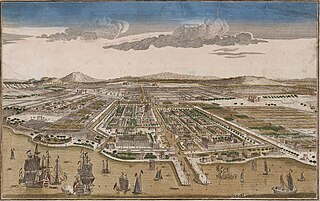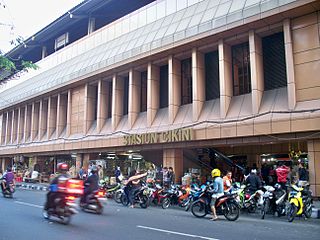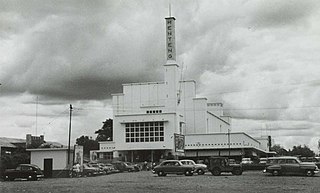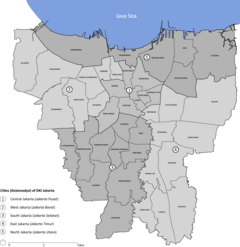
Menteng is a district in the administrative city of Central Jakarta, Indonesia. Menteng is surrounded by the districts of Senen and Matraman to the east, Tebet and Setiabudi to the south, Tanah Abang to the west, and Gambir to the north. Menteng is bound by the West Flood Canal to the west, Ciliwung River to the south and east, and Kebon Sirih Road to the north. Menteng is the district seat of the Central Jakarta government.

Senen is a long-established urban district of Central Jakarta, Indonesia that has kept many tourist attractions such as two museums, the National Library of Indonesia, Gelanggang Remaja Senen, and narrow alleys with old Chinese and similar style shops and restaurants. It was first developed in the 18th century as Pasar Senen when Governor Daendels established the bovenstad as the new center of government of the fledgling city. Its core remains in what is now the lower-division Senen District, Kwitang, Kenari, Paseban, Kramat, and Bungur. Senen is bounded by a railway line to the east, Ciliwung River to the west, Pramuka Street to the south, and Abdul Rahman Saleh-Kwini II-Senen Raya IV Street to the north. The name is derived from Pasar Senen,.

Pondok Indah Mall, abbreviated as PIM, is a large shopping mall complex located in the Pondok Indah suburb of South Jakarta, Indonesia. In January 2017, it was recognised by Forbes as one of the top five shopping malls in Jakarta. The Pondok Indah Mall complex comprises three large main buildings, the older 3-storey PIM1 and the 5-storey PIM2, and the newest building PIM3. PIM 1 and 2 are interconnected via two elevated multi-storey pedestrian walkways, which are also tenanted by specialty shops. PIM3, which was officially opened in 2021, is interconnected to the other two buildings by a walkway as well.

Kebayoran Baru is a district in the administrative city of South Jakarta, Indonesia. The name was derived from a planned satellite city of the same name which was developed in the post-war period. Kebayoran Baru was the last residential area to be developed by the Dutch colonial administration. The urban planning was laid in a concept of the Garden city movement, consisting of a well-planned residential area, a shopping center, and a business district, supported with civic facilities such as schools, places of worship, hospitals, and parks. Today, the district is home to many important government institutions, such as the Indonesia Stock Exchange building, the ASEAN Headquarters building, the National Police headquarters, and the City Hall of South Jakarta. Sudirman Central Business District is also located in the district.

The cinema of Indonesia refers to films produced domestically in Indonesia. The statutory Indonesian Film Board, or BPI, defines Indonesian films as "movies that are made by or using Indonesian resources whose Intellectual Property Right is owned either entirely or partly by Indonesian citizen or Indonesian legal entity".

Jakarta is Indonesia's capital and largest city. Located on an estuary of the Ciliwung River, on the northwestern part of Java, the area has long sustained human settlement. Historical evidence from Jakarta dates back to the 4th century CE, when it was a Hindu settlement and port. The city has been sequentially claimed by the Indianized kingdom of Tarumanegara, the Hindu Kingdom of Sunda, the Muslim Sultanate of Banten, and by Dutch, Japanese and Indonesian administrations. The Dutch East Indies built up the area before it was taken during World War II by the Empire of Japan and finally became independent as part of Indonesia.

Tunjungan Plaza (TP) is a mixed development superblock in Surabaya and is the second-largest shopping center in Indonesia after Pakuwon Mall, both owned-and-operated by Pakuwon Jati which has its headquarters inside the superblock. Initially inaugurated in 1986, it has a net leaseable area of 170,000 m2, which houses more than 500 retail outlets including boutiques, restaurants, cafes, cinemas, bookstores, supermarkets, and children's arcade center. It is a part of Tunjungan City Superblock, an integrated multi-facilities venue, which includes the mall, Menara Mandiri Office Tower at the top of TP 2, Regency Condominium and Sheraton Surabaya Hotel & Towers at the top of TP 3, Four Points by Sheraton at the top of TP 4, The Peak Residence and Pakuwon Center at the top of TP 5, One Icon Residence and Pakuwon Tower at the top of TP 6. First opened on 15 December 1986, it is divided into six buildings: TP 1, TP 2, TP 3, TP 4, TP 5 and TP 6.
PT Graha Layar Prima Tbk is a cinema chain in Indonesia. The chain was founded as BlitzMegaplex in October 2006. Today, it operates over 73 cinemas with 416 screens across 30 cities in Indonesia.

PT Nusantara Sejahtera Raya Tbk is the largest cinema chain in Indonesia, serving 46 cities in the country. It was founded on 21 August 1987 as Studio Twenty One.

Ismail Marzuki Park Jakarta Arts Center, is an arts, cultural, and science center located at Cikini in Jakarta, Indonesia. Taman Ismail Marzuki complex comprises several facilities including six performing arts theaters, cinemas, an exhibition hall, a gallery, libraries, and an archive building. The complex is built on a 9-hectare land area, which was previously a zoo. TIM is named after Ismail Marzuki, one of Indonesia's most influential composers.

Jalan M.H. Thamrin or Jalan Thamrin is a major thoroughfare in Jakarta, Indonesia. The road is located at the center of Jakarta, running from the north end of Jalan Jenderal Sudirman at West Flood Canal at the south end to the roundabout near Arjuna Wijaya Statue Jakarta at the north end. Developed in the 1950s, the road was a landmark of post-colonial Indonesia and continues to have a prominent importance in Jakarta.

Jalan H.R. Rasuna Said or Jalan Rasuna Said is one of the main avenues of Jakarta, Indonesia. It was constructed during the 1970s. It is located in the Golden Triangle of Jakarta. The road was named after Hajjah Rangkayo Rasuna Said, a National Hero of Indonesia. The road runs 4.9 km (3.0 mi) from Setiabudi, South Jakarta, to Tendean, Mampang Prapatan, South Jakarta. The Rasuna Said Street is also one of the Odd–even Traffic Restriction Scheme implementation zones.

Cikini Station is a railway station located on Jl. Cikini Raya, Cikini, Menteng, Jakarta. This station is only served by KRL Commuterline commuter trains from Jakarta Kota to Depok and Bogor.

Hotel der Nederlanden was a historic hotel in Jakarta, Indonesia. Hotel der Nederlanden was one of the three grand hotels in Batavia during the last period of the colonial rule, the other being Hotel des Indes and the Grand Hotel Java. The hotel had operated for more than a century, after which it was demolished in 1969 and was replaced with the Bina Graha presidential office.

Menteng Cinema was a cinema in Jakarta, Indonesia. The cinema was designed by Dutch architect J.M. Groenewegen in 1949, one of the architect who was active in Indonesia before and after the World War II. Menteng Cinema is Groenewegen's first cinema project, which would give birth to several other cinemas in Indonesia which has the same architectural style of Nieuwe Bouwen. Menteng Cinema was demolished in 1988, standing above the site now is the Menteng Huis shopping complex.
The Golden Triangle of Jakarta, also referred to as the Medan Merdeka–Thamrin–Sudirman Axis or the Sudirman–Thamrin–Kuningan Axis, is a roughly triangular area in the center of Jakarta, Indonesia, extending from Central Jakarta to South Jakarta. Most of the city's tallest skyscrapers, office buildings and foreign embassies are located in the area. It is the main CBD of Jakarta.
Jalan Lieutenant General MT Haryono or Jalan MT Haryono is one of the main roads of Jakarta, Indonesia. The road is named after an Indonesian National Hero Lieutenant General Anumerta Mas Tirtodarmo Haryono. This road stretches 3.5 KM from Cawang, Kramat Jati, East Jakarta to Pancoran Statue, Pancoran, Pancoran, South Jakarta. This road is traversed by Jakarta Inner Ring Road and TransJakarta corridor 9 and 7. This road was built in 1970's as Gatot Subroto Road had continued past Tebet and becoming M.T. Haryono Road to Cawang and meet the junction with Major Jendral Panjaitan Road. This road crosses 9 urban villages of Jakarta, namely:
The Park Pejaten is a shopping and entertainment center with a family allotment located on Jalan Warung Jati Barat, Jati Padang, Pasar Minggu, Jakarta in Indonesia. It was built in 1991 as Pejaten Mall, but in 2007 the management, as well as the name, was changed to Pejaten Village. Later in 2020, the management was changed again, and the mall was renamed to its current name.

The Youth Pledge Museum is a historic museum of the independence struggle of the Republic of Indonesia. It is located in Jalan Kramat Raya No.106, Central Jakarta and managed by the Ministry of Culture and Tourism. The museum is open for public, every Tuesday until Friday from 08.00 to 15.00, every Saturday and Sunday from 08.00 to 14.00, and closed every Monday and national holiday.

Sarinah Building is a 74-metre tall 15-floor department store in Gondangdia, Menteng, Central Jakarta, Indonesia. It was the first skyscraper to be built in Jakarta.


















